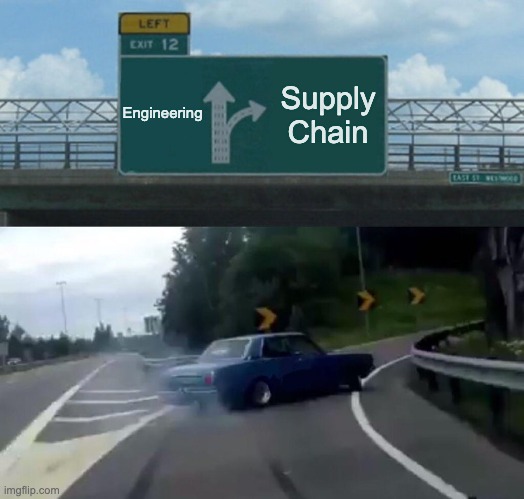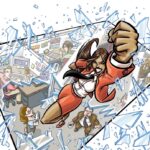Like most supply chain/procurement professionals, I definitely didn’t start here. I was going to be an engineer, climbing the expected chain from Design Engineer to Project Engineer to Engineering Manager and then maybe VP of Engineering. It was going to be organized, orderly, and predictable, and all of those older professionals I talked to were simply wrong when they said I couldn’t predict my career. (Yes, you’re allowed to laugh along with me here.) Today’s article is particularly useful if you’re an engineer moving into supply chain, an engineer who deals with supply chain a lot, a supply chain professional looking to add a different angle to your work, or if you’re a hiring manager contemplating how to round out your team. Since moving into a supply chain role, I’ve met fellow practitioners who come from marketing, finance, Spanish, various engineering specialties, electronics design, and of course many with no post-secondary degree at all. So today’s article focuses on the journey from engineering to the supply chain – the good, the bad, the ugly, and the unexpected.
The Good
A story I’ve told multiple times comes from a few months after I moved from being a design engineer to being an engineering buyer at an equipment manufacturer. (Side note: if you’d prefer to watch me tell this story via YouTube Short, you can find it here.) The sales person sitting across the table from me was a representative from one of our major cylinder manufacturers and he excitedly explained that they had a new steel alloy available in their products. He did not know I was still very much an engineer at heart, and I asked if he had a technical spec sheet with him. He dug in his briefcase for a moment before producing it for me to review. “Oh, that’s just Chromoly!” I told him. It really wasn’t his fault and I don’t think he was trying to fool me, but my engineering training and experience came in very handy at that moment. When supplier representatives would learn I had training as an engineer, the good supplier partners could bounce new alloys or formulations off me before going to the engineers. I had one plastics supplier who would call me with things like, “I have this new formulation that’s much more abrasion-resistant than our old one. Here’s a part number, would abrasion-resistance be helpful here?” I could pull up the machine drawing on my computer and give the application an initial glance to see if it was worth taking the idea to the engineering team for review.
Similarly, I once had an engineer come back from lunch with a design for a plastic part literally drawn on the back of his napkin (soup stains and all). At that point they hadn’t taken away my Solidworks CAD license yet, so I drew up his sketch in CAD and sent it off to suppliers to quote.
The third “good” thing that comes from bringing engineering experience into the supply chain is the process and problem-solving mindset engineers are trained for. When engineers receive a problem to solve, they are trained to:
- Restate the problem – in the case of word problems from a textbook, this means simply copying the problem. But in the workplace, this often is the hardest step and one that is frequently skipped. A group of people are all trying to solve a problem, but each person has a different understanding of the problem they are trying to solve. Restating the problem should always be the first step to solving any problem.
- State assumptions – we all make assumptions when solving a problem, and it’s helpful to state these assumptions out loud so everyone can examine them for fallacies. In solving supply chain problems, there are often assumptions like “Tariffs will be X% when we purchase this material” or even “Cost is more important than lead time for this bid” (Remember your iron triangle and always include the order of importance in your assumptions!) Some of these assumptions might even help guide your evaluation criteria.
- Develop solutions – come up with multiple solutions to the problem, or multiple methods to solve it. This might include a brainstorming session, in which case try to include a cross-functional team whenever you can. No idea is “wrong” and nothing gets thrown out in this phase. All crazy ideas are valid because often crazy or silly ideas lead to creative realistic ideas.
- Evaluate solutions – pitch your potential solutions against your desired outcome, considering cost, quality, speed, and personnel. If multiple solutions rise to the top, try to pick one to move forward with because this stage is the one where problem solvers get stuck and end up thinking about all the solutions instead of solving problems. Just move forward.
- Check your answer – this is the other step that often gets missed! We get so tangled up in which solution scored the highest in the “evaluate” stage that we don’t then stop and look at the final answer. Is it actually reasonable? Or would any six-year-old (much less your CEO or supply chain leader) look at you and tell you your answer makes no sense? Your solution doesn’t have to be perfect or ready for an executive review, but it should make sense for your company, your budget, your culture, and the larger world.
The Bad
There are some distinct drawbacks to coming into the supply chain from engineering, the least of which was when someone had to explain to me what an “RFP” was and why we do them. First, I’ve observed that engineers tend to be oddly wordy in communications (when we can be bothered to communicate at all). We now have AI to help us summarize long emails, but I definitely had to learn how to write shorter emails. The person on the other end didn’t need to know every detail of my thinking, and I’ve observed this behavior in other trained engineers. In a supply chain, a good executive summary is far more important than as an engineer.
I had to learn when to ask for help, including when and how to loop my boss into the kinds of problems that would cause us all trouble later. While I think every role has to learn this when we join the workforce, I found it especially challenging because the problems were things like, “I might have made this person mad at me” instead of “I need someone to check my calculations on this structure.” The first one is ambiguous and got me into trouble. The second one feels more clear cut and obvious.
I also had to learn to deal with ALL the email! As a design engineer, I received maybe 90 emails a week, many of them company-wide announcements about safety or notes about donuts in the breakroom. While I know in a more virtual world email has a higher volume than it did in 2009, as soon as I moved over to procurement the email volume exploded. It was common to get a thousand emails a week, outlining specs or requesting things from me. I had to learn email management in a way I hadn’t ever needed to as an engineer.
The Ugly
While the previous section did some of this, this section is where I have to air out some dirty laundry. The biggest “ugly” piece of moving from engineering to supply chain was that engineers aren’t usually very good at building relationships. Supply chain professionals don’t succeed well without good relationships – with suppliers, with their internal customers, and with company leadership. While getting an MBA did help with this, it just took years of learning, good mentors, and a lot of work to learn how to build professional relationships and networks. If you’re an engineer moving into supply chain or you are mentoring one, this is probably an area for emphasis.
Similar to the need to build relationships, I had to learn a lot of diplomacy to succeed as a supply chain professional. Supply chain team members talk to ALL levels of an organization, and executives don’t always look favorably to being told they’re wrong if it’s not done well. Good executives will indeed listen to reason or learn when something they are doing is costing the company money, but telling them so with clear, kind language delivered to them in private instead of in front of their team will go much further toward accomplishing goals. Some people already know this, but for me, it had to be learned. Maybe all universities should have a course on “how to speak truth to power” as I’ve had several friends over the years struggle with doing so without losing their jobs.
The last thing I think belongs in the “ugly” category is that no one knew what supply chain or procurement were before the COVID-19 pandemic. People would ask me what I did for a living, and I would tell them procurement, or maybe supply chain or purchasing depending on who I was talking to. I often received a response like, “Oh, so you shop for a living?” Um, no. I don’t shop for a living. I don’t think I’d like procurement much if I did – I don’t actually love to shop. But after COVID and the supply chain breakdown that followed, I can tell people I work in supply chain and they say, “Oh! You’re the people who make sure we all have toilet paper!” Yes . . . sort of . . . that’s me.
The Unexpected
Any major shift in career tends to come with unexpected things in addition to the good, the bad, and the ugly. Here are a couple of things about moving from engineering to supply chain that surprised me.
First, knowing a little bit about multiple things is an asset for supply chain, not a liability. As an engineer, I needed deeper knowledge about a more limited number of things. I know engineers who spent their entire 30-year career with a tractor or machinery company designing just the cylinders for internal combustion engines. Every time I met another engineer like that, I cringed. That sounds so boring to me! I’m a collector of information. I would rather know a little bit about everything and keep finding new topics to learn. As an engineer, that meant I found it hard to reach the depth of knowledge others expected of me. But in a supply chain role, it means I know just enough about a wide variety of topics to be able to check a scope of work, talk to suppliers in a variety of categories, and converse well with a wide variety of team members.
The last unexpected thing about moving to the supply chain team was the salary. Supply chain professionals negotiate for a living – it’s what we’re paid to do. So it makes sense that we’re aggressive negotiators with our own salaries. When I first moved from a design engineer to an engineering buyer position, the compensation team told me (to my surprise) that it was a lateral move. I did tell people this when they asked about my new role, and my HR rep called me into his office to say just because compensation was matching my salary, that didn’t mean it was lateral. I had him call the compensation team and verify that an engineering buyer was always at the same level as a design engineer. I wasn’t even the best-compensated of the eight engineering buyers. I felt a bit like I was benefiting from the excellent negotiators who came before me, but it was an unexpected surprise and I’ve found it to be true in multiple companies and multiple industries. A Category Manager is just as worthy of respect (and often as well-compensated) as a Senior Engineer.
Hopefully my experience moving from engineering to supply chain is helpful and applicable to your work, your team, and your future endeavors. If you would like to talk about your supply chain journey, let’s chat. If you’d like to get these articles weekly straight to your inbox and never miss one, sign up for my newsletter.
My book, Transform Procurement: The Value of E-auctions is now available in ebook, paperback and even hardcover format: https://www.amazon.com/dp/B0F79T6F25




